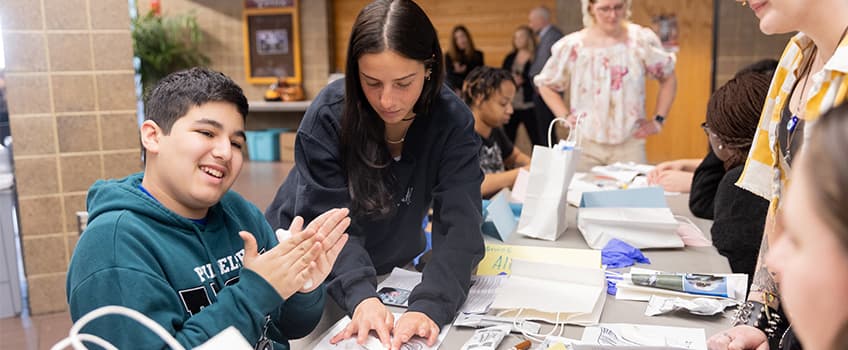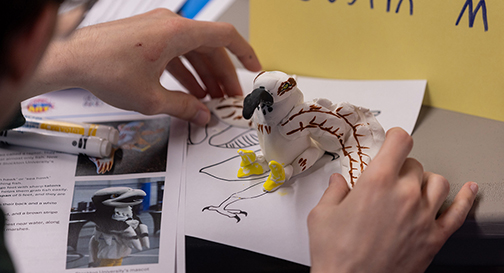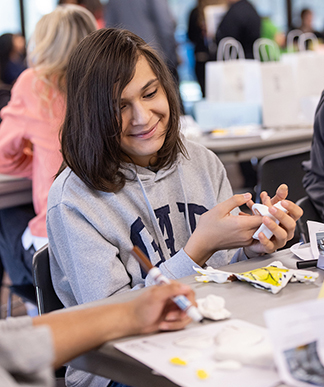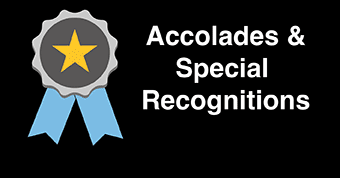Workshop Provides ‘Eye-opening’ Fun for Disability Studies Students

Junior Alicia Klotz, a Health Science major from Freehold, works on creating a Stockton osprey out of clay with Christopher Hood of the Atlantic County Special Services School during the on-campus Access to Art Disabilities Workshop on April 10 in the Lakeside Lodge.
Galloway, N.J. — Dana Grasso became a little sentimental when talking about Stockton University’s first Access to Art Disabilities Workshop with the Atlantic County Special Services School.
“I know that one parent shared with the teachers that they were very emotional because they felt as though this was the only opportunity their young adult would have to be on a college campus, and it was really meaningful for them to have this opportunity,” said the teaching specialist in the university’s School of Education.
Grasso helped organize the visit of about 40 Special Services students last week to take part in the Access to Art program. Access to Art was created last year by the Noyes Museum of Art of Stockton University thanks to $70,000 in funds from the Atlantic Center for Independent Living (ACIL), a Galloway-based nonprofit that advocates and provides life skills training and services for people with disabilities.
 Stockton and Atlantic County Special Services students worked together to construct
clay versions of the university's mascot -- the osprey -- during the workshop.
Stockton and Atlantic County Special Services students worked together to construct
clay versions of the university's mascot -- the osprey -- during the workshop.
“These kids don’t get the opportunity to do stuff like this very often,” said Christen Vogel, a teacher in the multiple disabilities department at Atlantic County Special Services. “They were very excited about it. All the kids couldn’t wait to come. They were just excited to even be on the bus. When we got here, they all said, ‘We’re at Stockton!’”
Once they arrived, the Special Services students were paired up with about 50 Stockton students from the university’s Disability Studies minor to help create clay versions of the school’s mascot — the osprey. Michael Cagno, the executive director of the Noyes Museum, said he looked for a project that would be adaptable and flexible since the Special Services students have a wide range of individual disabilities.
“You are watching the enthusiasm of both college and elementary school students coming together and bonding over the process of creating art,” Cagno said.
Although many of the Special Services students couldn’t vocalize how they felt about the workshop, Johnna Moscony could tell her students had a great time. The teacher in the Atlantic County Special Services autism department said many of her students communicate mostly through gestures, facial expressions and nonverbal vocalizations, but their behavior while working with the clay spoke volumes.
“They were calm. They were engaged, and in such a different environment, that’s not always the case,” Moscony said. “The way the Stockton students embraced our kids, you could just tell from our kids’ reactions how happy they were to just be among the (Stockton) students.”

Arturo Diaz-Ruiz, 14, of Hammonton, smiles as he works with clay to create an osprey.
Arturo Diaz-Ruiz got a big smile on his face once he learned he was going to work with clay.
“I’m really having a good time. Making an osprey is my favorite part. I really like to work with clay in art club,” said the 14-year-old from Hammonton. “I like to make little bowls and plates.”
Diaz-Ruiz’s smile became infectious, not only with his classmates, but with many of the Stockton students as well.
April Zeleznok helped her student, Yangel, create a “new species of golden osprey.” Yellow is Yangel’s favorite color.
“It’s been a great experience to see today how inclusive a classroom can be,” said the sophomore Liberal Arts major with a concentration in Elementary Education. “It shows the diversity of each student and that you have to have patience and explain things in different ways because every student is different.”
Zeleznok, a sophomore from West Creek, said she initially had some difficulty explaining to Yangel how he could make the osprey look three-dimensional. The exercise forced her to rethink how she communicated with him.
“He didn’t understand what 3-D meant. So, it really taught me that you have to use a different vocabulary for different ages and different types of students,” Zeleznok said, adding that Yangel understood her better when she asked him to make the osprey’s wings thicker.
The workshop also provided a hands-on teaching environment for the Stockton students, many of whom were enrolled in Grasso’s “Inclusive Learning in Education” class, which is one of the first Education majors take at Stockton.
“This helps the students to start to think about how you are going to have students with disabilities, even if you are a general education teacher,” said Grasso, who has worked with students with disabilities for 14 years. “This is a meaningful experience that we can’t provide in the classroom. No matter how many videos, or first-person interviews that we have, it’s not possible to replicate that. For them to actually sit down and engage with these students, it was really eye-opening.”
After the workshop, Grasso said several students approached her because they are now interested in working with students with disabilities.
“It was a lot more fun that I thought it would be,” said junior Jordan Sessler, a Biology major who wants to teach that in high school. “Working with these kids, they offer different perspectives. There are different things you have to worry about, but really once you get working with them, you see there’s no difference. They’re still kids. They’re excited, and they want to do this, and I can still have the same connection with them.”
Cagno and Grasso hope to provide more disability workshops for the Special Services students in the future through Access to Art.
“The arts give so many opportunities, not just economic development, but educational programs that provide what you are seeing here today,” Cagno said. “It’s irreplaceable. It’s the authentic development of bonds between people. That’s what art is all about.”
— Story by Mark Melhorn, photos by Susan Allen


